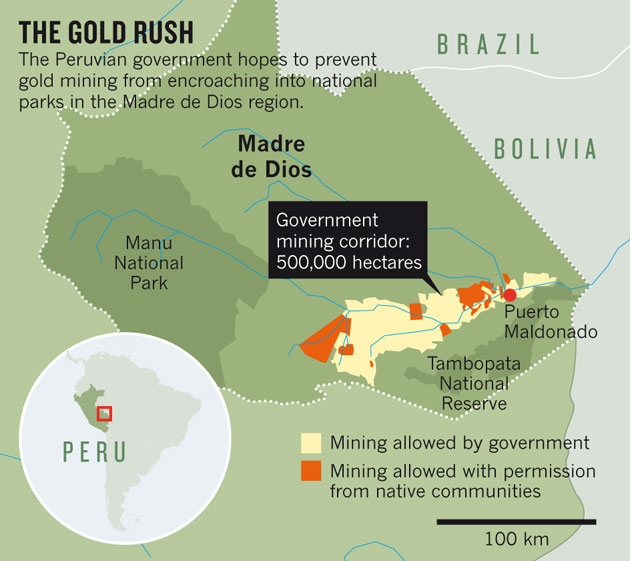Goblins
Syndrome Facial Features … Animated morphs of average faces from controls to syndromes. “Diagnostically relevant facial gestalt information from ordinary photos.”
Environmental Toxicants and Autism Spectrum Disorders … Exposures to environmental toxicants such as mercury, lead, arsenic, polychlorinated biphenyls (PCBs) and toluene are known causes of neurodevelopmental disorders.9Approximately 85 000 chemicals have been manufactured in the United States, and although only about 2800 are used in high volumes (more than one million pounds produced per year), little information exists about the developmental toxicity for most of these, including many that are in common use today.10
The Stolen Child (The Waterboys)
*
Mercury and Gold Mining … Madre de Dios is at ground zero of Peru’s gold rush: an estimated 30,000 artisanal and small-scale miners work in this lush Amazonian area, one of the most biologically diverse places on Earth. Scientists and conservationists are alarmed by the damage that mining is causing to the land and its people. …
An estimated 45–50 tonnes of mercury are used each year in Madre de Dios to extract the prized gold, and a large proportion of that ends up in rivers or is released into the atmosphere.
Miners combine mercury with sediments that contain gold — typically using their feet to mix them in a bucket or drum — to form a solid amalgam of the two metals. That amalgam is then heated, often in frying pans over open flames in non-ventilated spaces, to boil off the mercury and leave gold behind.
Over three millennia of mercury pollution in the Peruvian Andes … Cinnabar (HgS) is the primary mineralogical source of mercury (Hg), and forms a bright red pigment (vermillion) when powdered. In the Andes, the use of vermillion is closely tied to that of precious metals, and vermillion has been recovered in burials of the elite from the first (Chavín) to the last (Inca) Andean empires, where it was used as either a body paint or a covering on ceremonial gold objects (1). During the Colonial era (1532–1900 AD), large-scale Hg mining began in earnest with the invention of Hg amalgamation in 1554 AD (2). For the next 350 years, Hg amalgamation became the dominant silver processing technique because it allowed for the extraction of silver from low-grade ores (2, 3). Nriagu (2, 3) estimated Colonial Hg emissions totalled 196,000 tons, averaging ≈600 tons·year−1; approximately equivalent to current emissions from China (4). …
… Cinnabar is the dominant mercuric ore, and >90% of historically documented cinnabar production has been from the Santa Bárbara mine, immediately south of Huancavelica (5). Frequent cave-ins and extensive Hg poisoning throughout Huancavelica’s 450-year Colonial history have made it one of the most sinister examples of human exploitation and disastrous mining environments ever documented, earning it the nickname mina de la muerte (mine of death) (5, 6). …
Question: What is the probable area of distribution of the mercury emissions from the Santa Barbara Mine, at concentrations greater than presently accepted levels for health and safety?
Exploring the Link between Manganese and Parkinson’s Disease … MANGANISM has been known about since the 19th century, when miners exposed to ores containing manganese, a silvery metal, began to totter, slur their speech and behave like someone inebriated. The poisoning was irreversible, and soon ended in psychosis and death. …
Being harder than iron, manganese is often used to strengthen steel and is present in many industrial emissions, including welding fumes. …
The American standard for the airborne concentration of manganese dust is now 5 milligrammes per cubic metre of air—a vast improvement on the doses of close to 1,000mg/m3 that some workers were exposed to only 60 years ago. Last year, Robert Park, a statistician with America’s National Institute for Occupational Safety and Health, published a review which concluded there was good evidence of neurological effects at concentrations lower than 0.2mg/m3.
Arsenic and Gold Mining … Canada’s taxpayers ante up billions to clean up the mistakes of the past. Welcome to the Giant Mine, an abandoned gold mine in Yellowknife, capital of the Northwest Territories (see map). The Canadian government first took charge of it in 1999 after the owner declared bankruptcy and walked away. It is one of an estimated 10,000 orphaned or abandoned mines in Canada’s north that are now the government’s responsibility. And it is full of arsenic trioxide, a compound that is produced by heating arsenopyrite ore, a mineral that has traces of gold. Arsenic trioxide is odourless, tasteless, highly soluble—and lethal. An amount smaller than a pea is enough to kill. The Giant Mine has 237,000 tonnes of the stuff.
The Anthropocene … Humankind is becoming a geological force. In 2000 Paul Crutzen, an eminent atmospheric chemist, realised he no longer believed he was living in the Holocene. He was living in some other age, one shaped primarily by people. From their trawlers scraping the floors of the seas to their dams impounding sediment by the gigatonne, from their stripping of forests to their irrigation of farms, from their mile-deep mines to their melting of glaciers, humans were bringing about an age of planetary change. With a colleague, Eugene Stoermer, Dr Crutzen suggested this age be called the Anthropocene—“the recent age of man”.
Farewell To Clayoquot Sound (The Wyrd Sisters)
Sickly Sweet (Klaire de Lys) … Makeup tutorials for Hallowe’en. If we could not laugh at the horrors of the world, surely we would go mad. By the way – what chemicals are in those candies? And what is in that face paint?
Goblin Market (Christina Rossetti, 1830-1894)






You must be logged in to post a comment.